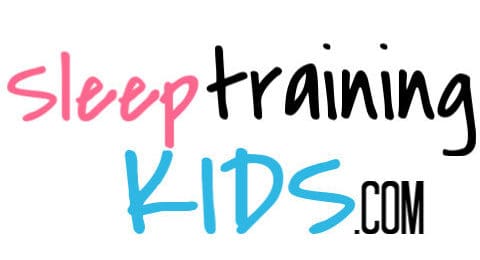While you’re sleep training and in the middle of all of those sleepless nights, it’s easy to wonder when it will end or if it’s making a difference. So how do you know if sleep training is working or not?
Sleep training is working if there is a slow, steady, or measurable improvement in sleep quality, quantity, and overall happiness for both the child and the parent. Results are typically measured in weeks and months rather than over a single or even several nights.
Ready to know if sleep training is working for you? Keep reading – and we’ll discuss exactly how to know if sleep training is working.

How to Know if Sleep Training is Working
There are several, easy-to-measure ways to know if sleep training is working for your family. So as you’re sleep training, keep track of each of these things.
- Sleep quality (both during naps and nighttime)
- Sleep quantity (both during naps and nighttime)
- Overall happiness and levels of playfulness for your child
- Overall health for everyone involved
If your child’s sleep quality, quantity, happiness, and health are generally improving, then sleep training is working. It may be that only a couple of the metrics improve at first. It may take time for the rest to improve, too. However, as long as things are getting better, it’s still an improvement and an indication that sleep training is working.
Depending on how you best track data, you may do best by keeping a simple list of how things are progressing. Or perhaps you do better using a scale of 0-10, where 10 is the ideal for the baby’s age and 0 is the worst possible nighttime scenario.
In either case, you’ll want to keep all of your data in one place, like in this handy-dandy sleep training journal and planner (available on Amazon) that we designed based on our own experiences and after working with hundreds and thousands of sleep-deprived parents.
Here is how you might keep track of some of the measurements.
| What to Measure | Average Timeline to See Results | Example (with a 10-month-old boy) |
|---|---|---|
| Sleep Quality | It may take several nights or weeks | Our son slept soundly and fell asleep last night. He only woke up once instead of each hour, but did require feeding and being held to fall back asleep. Rating: 7/10 |
| Sleep quantity (nighttime) | Several nights or weeks to see trends | Our son slept 9 hours last night instead of 6. This shows improvement towards his needed amount of 11 hours each night. Rating: 8/10 |
| Overall happiness | May see overnight improvement | The baby woke up happy and rested! He was ready to play. We watched him for signs of sleepiness to initiate his morning nap. Rating: 9/10 |
| Overall health | May see improvement over several nights | He’s been getting over a cold. Getting enough sleep has been hard, but it’s helping him recover better. Rating 8/10 |
Just keep in mind that tracking these results shows trends. You’re going to need several nights’ or even weeks’ worth of data to see any conclusive evidence as to whether things are working or not.
In our experience sleep training our children, nighttime sleep quality and quantity had to be addressed and improved first – before we could see any naptime improvements. Overall happiness and health were also quick to improve with sleep training.
As you keep track of these metrics, you’ll be able to tell if sleep training is working for your family – or not.
How Long Sleep Training Usually Takes to Work
Remember that, depending on the sleep training method you’ve selected, sleep training may take anywhere from several days to weeks.
- For methods that involve some measure of crying, sleep training may only take as little as 5-7 days.
- Tears-free sleep training methods usually take 1-2 weeks or more to see initial results.
Read more about how long sleep training takes in our article on it here.
So as you’re sleep training, keep track of how things are improving. Or, keep track of things as they aren’t improving. That way you’ll be able to know if things are on track – or if you need to pick a different sleep training method.
To read more about the various types of sleep training methods, read our article on them here. Be sure to bookmark this article in case you need to pick a different method.
How to Know if You’re Done Sleep Training
There are two main ways to know that you’re done with sleep training.
- Your children are able to sleep well and no longer require dedicated efforts to encourage proper sleep habits.
- Your children are able to sleep well but require continued, dedicated efforts to promote proper sleep habits.
You won’t know which route your child will choose for you until you’re there, unfortunately. Sometimes your child will surprise you.
Our oldest child required intensive sleep training for several months. Once he got it, he did well. He’s 9 now and is a great sleeper. We do have to check in on him to make sure he puts his book down to go to sleep, but otherwise, he self-manages his sleep pretty well. Our youngest son, on the other hand, continues to hate and fight at bedtime. He also does well once asleep – unless he’s sick.
Thankfully, even with a continued effort on sleep training, it’s mostly aimed at bedtimes and bedtime routines. It’s also commonly an issue with naps and naptime routines as long as your child naps – and things do get thrown out of whack with nap transitions.
However, as your child continues to grow, the middle-of-the-night sleep issues usually become a non-issue – at least, until there’s an issue like a stomach bug. Then, there may be a few rough nights until everyone’s doing better.
So as your child grows, remember that sleep training won’t have to be as dedicated an issue. Things will calm down and become better. Just give it some time.
How to Know if Sleep Training Isn’t Working
As you keep track of your child’s reactions to sleep training, you should notice one of two trends. The first we talked about earlier – it’s that things are working.
The second trend would be that things aren’t working. Here are some examples of what you may notice:
- Sleep quality of naps or nighttime sleep is not improving. In fact, it’s getting worse.
- Sleep quantity has become worse and nighttime wakings are becoming more frequent or just more. Naps may also be suffering.
- Overall, your child is more tired, miserable, and cranky.
- Your child may be more prone to sickness.
While you may only notice one or two of these, it’s more common to see all of them together. Because if sleep training fails, it tends to fail catastrophically. It can be a totally epic fail – I’ve experienced it several times!
If you’ve noticed these things, it could mean that sleep training isn’t working. However, it could also mean that your child is ill. If you suspect an illness or underlying medical concern to be the culprit, please see your child’s pediatrician or doctor.
Then, reevaluate the sleep training method you’ve been using and consider trying a different method. Or, see if it’s just one aspect of the method that needs to be adjusted to work better for your family.
Just remember that one method’s failure does not reflect upon your status as a parent. Instead, it means you’ve found one method that doesn’t work for your family and your child. Keep trying – and find a method that works better for everyone. That way, you’re showing your true mettle and dedication as an amazing parent who keeps trying.
When to Quit Sleep Training
There are some times and situations where quitting sleep training might be your best option. You will want to consider quitting sleep training if your child is too young, things are too stressful, or things are in the “catastrophic failure” category.
This doesn’t mean you’re quitting forever, though. Here’s how it usually looks.
- Usually, most parents find that giving themselves permission to temporarily quit their current method is enough.
- Then, they’ll usually take a day or two (or several weeks) where they don’t do any dedicated sleep training.
- Finally, these parents find that trying a different sleep training method that’s more in tune with their parenting style was the secret sauce to sleep training success.
To read all of the details and specifics on when and why to quit sleep training, be sure to read our complete guide on it here.

What Happens After Sleep Training
In my experience and research, being done with sleep training is an amazing step in the parenting journey. It’s not the end, though!
What happens next is that you continue to gain confidence in your parenting skills – just in time for your child to need help with something else. Even so, you’ll continue to rely on the skills of patience, paying attention, and evaluating results that you’ve learned through sleep training to continue along this crazy parenting journey we’re taking together.
But on the plus side, once sleep training is done, at least everyone’s (usually) getting enough sleep. So hang in there, friend. Things get better – and then they change and are both the same and completely different. 🙂
Related Questions
How Long Should Baby Cry it Out? Answer those questions in 200-300 characters as if for an encyclopedia. May include links to articles on your own website.
Is Sleep Training Bad? Answer those questions in 200-300 characters as if for an encyclopedia. May include links to articles on your own website.
Get Sleep News and Tips in Your Inbox.
Any time there’s a new sleep study or a significant change in sleep training methodology, you’ll get an email with our explanation of it – and information on how you can implement the latest evidence-based research and practices. We only send emails a few times each month, max.
Join the Sleep Tight newsletter community!
It’s free to get cool stories, updates, and more. Subscribers get exclusive access to some cool extras and downloadable files via the subscriber-exclusive library.
We use SendFox as our email marketing platform. By submitting this form, you acknowledge that the information you provided will be transferred to SendFox for processing per their terms of use.
